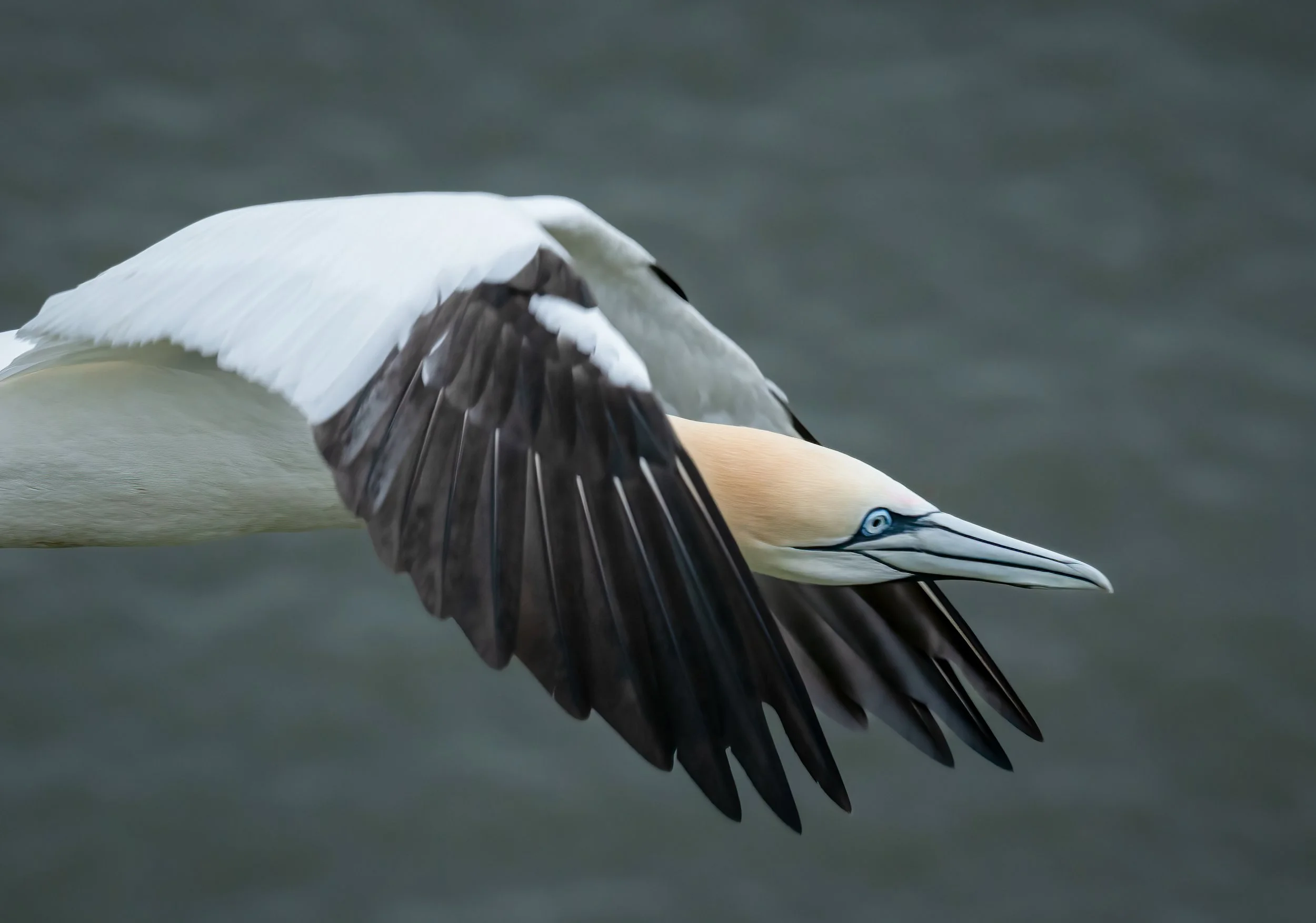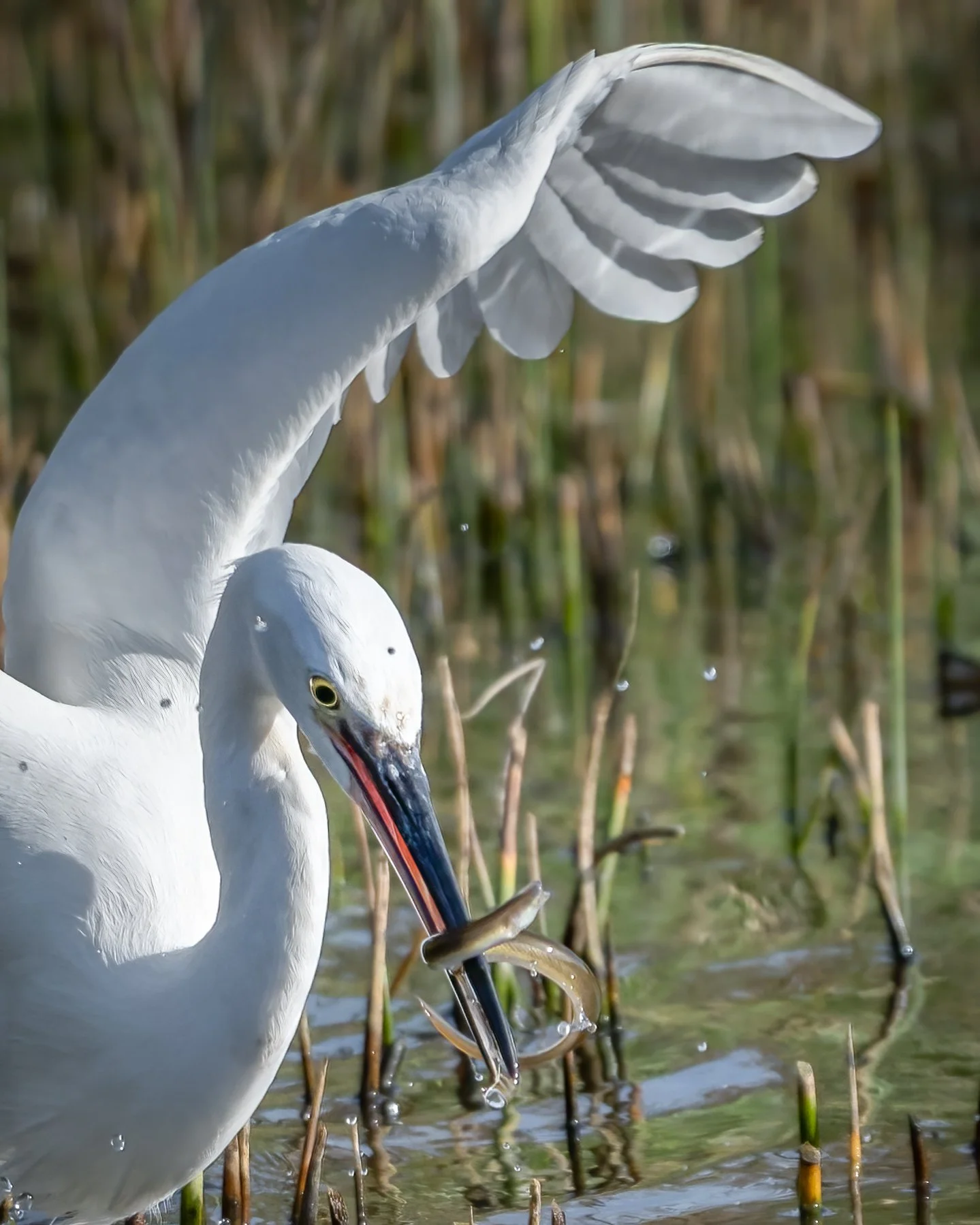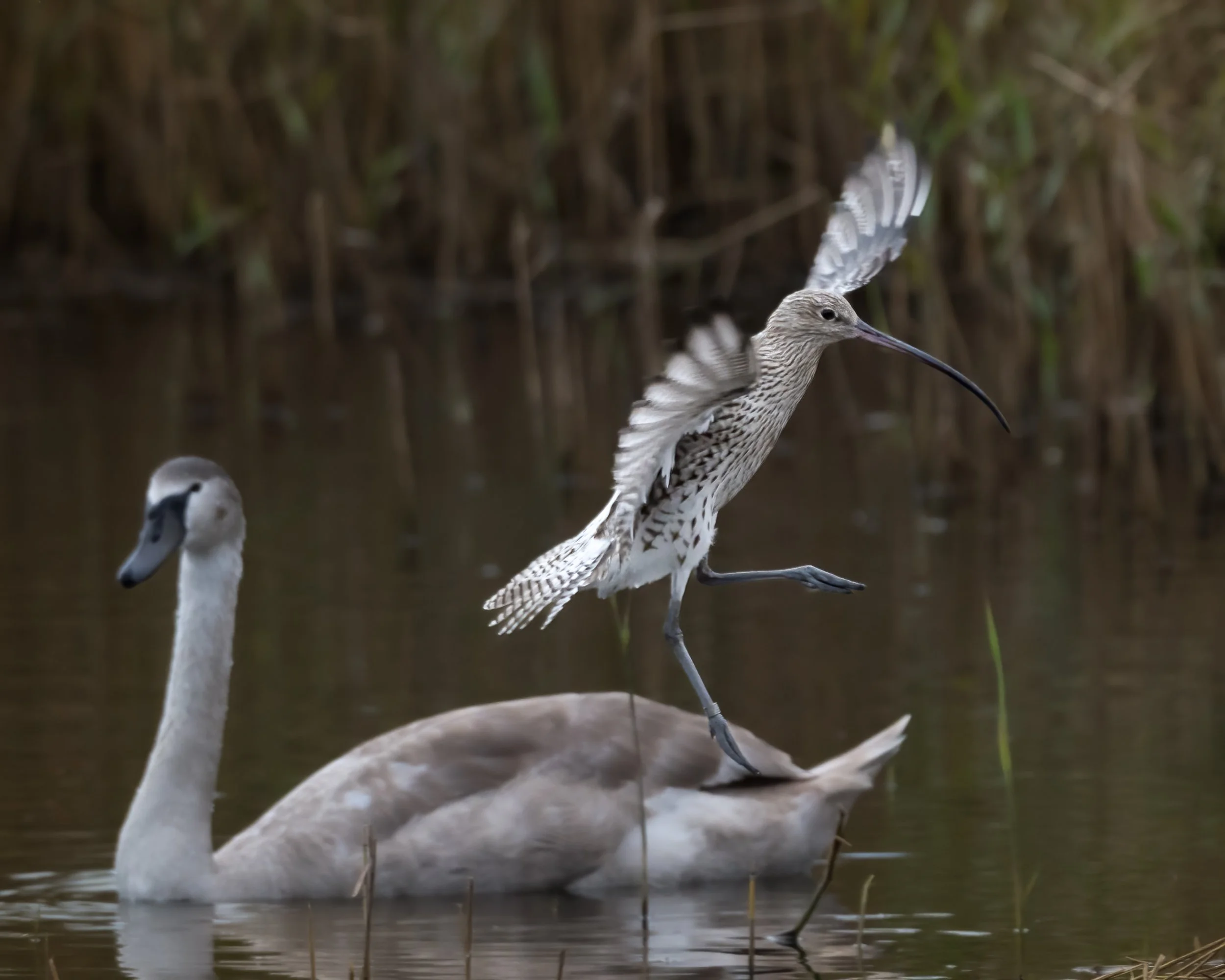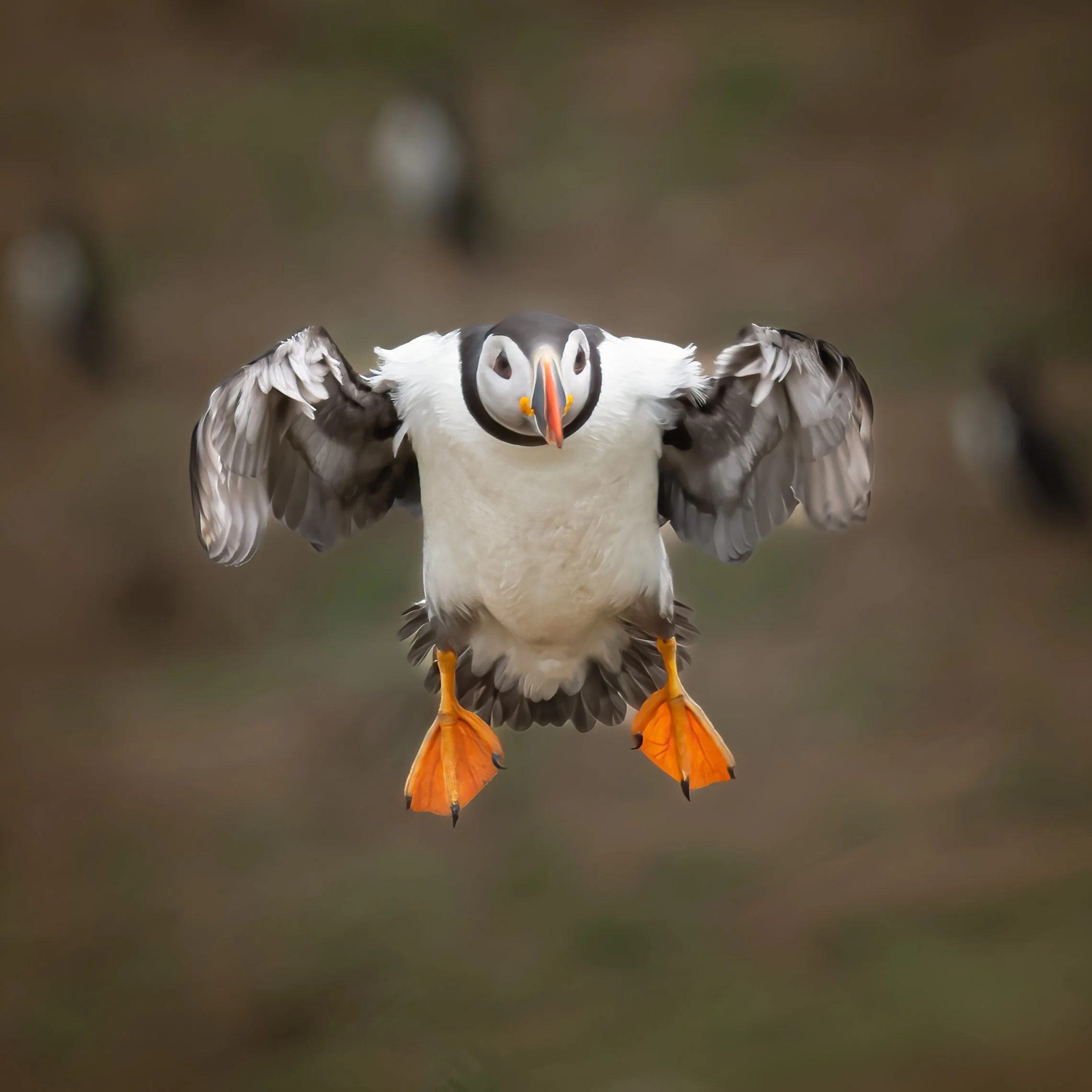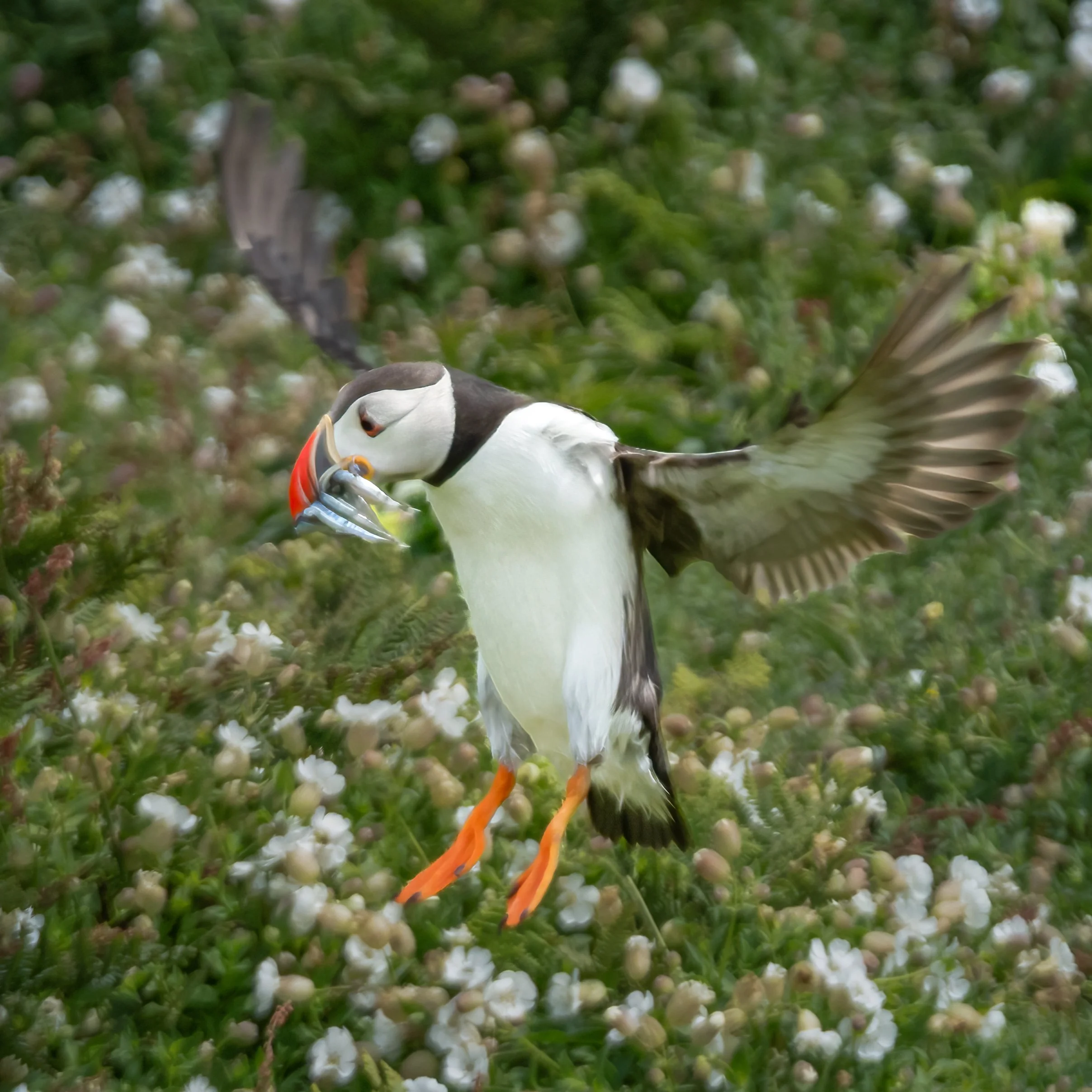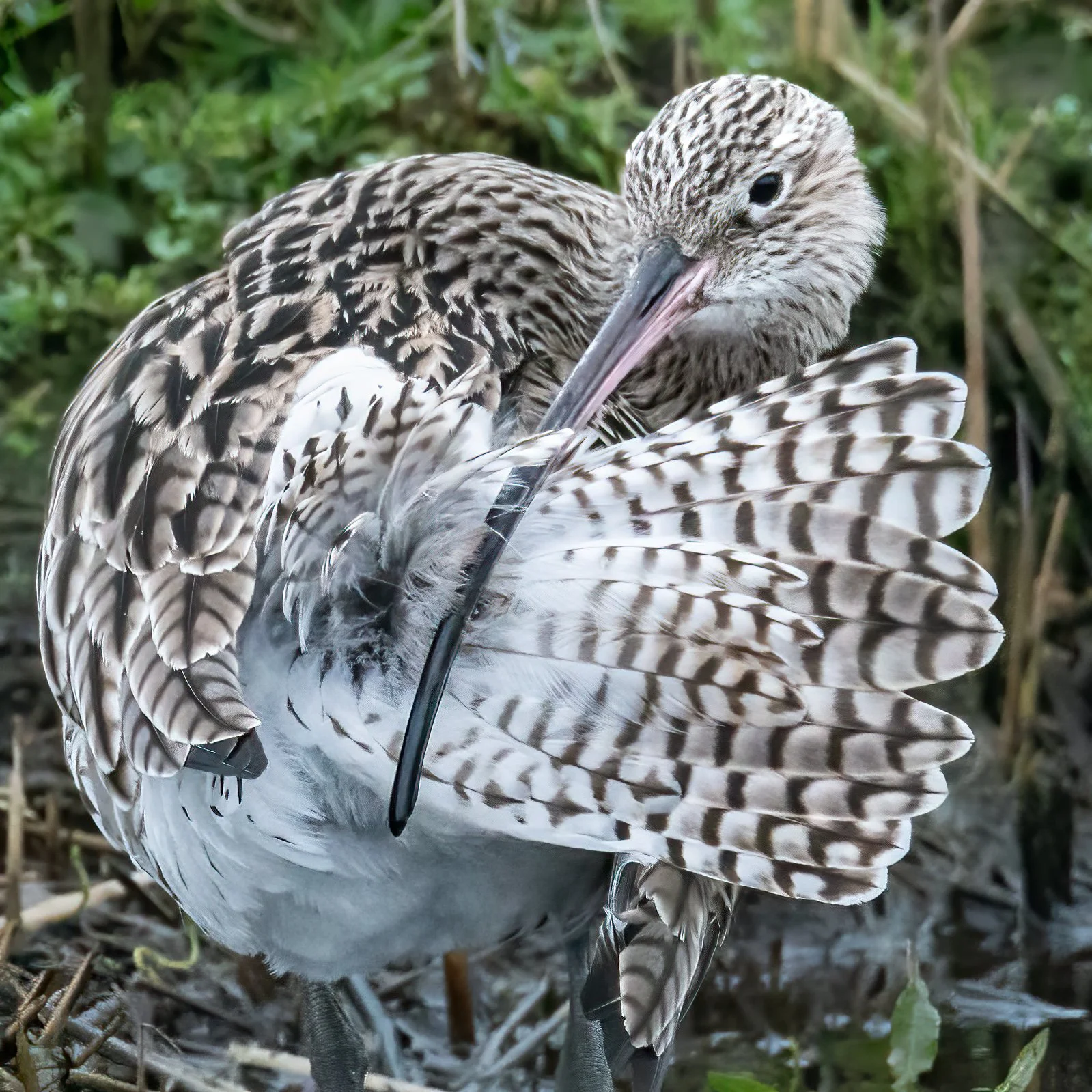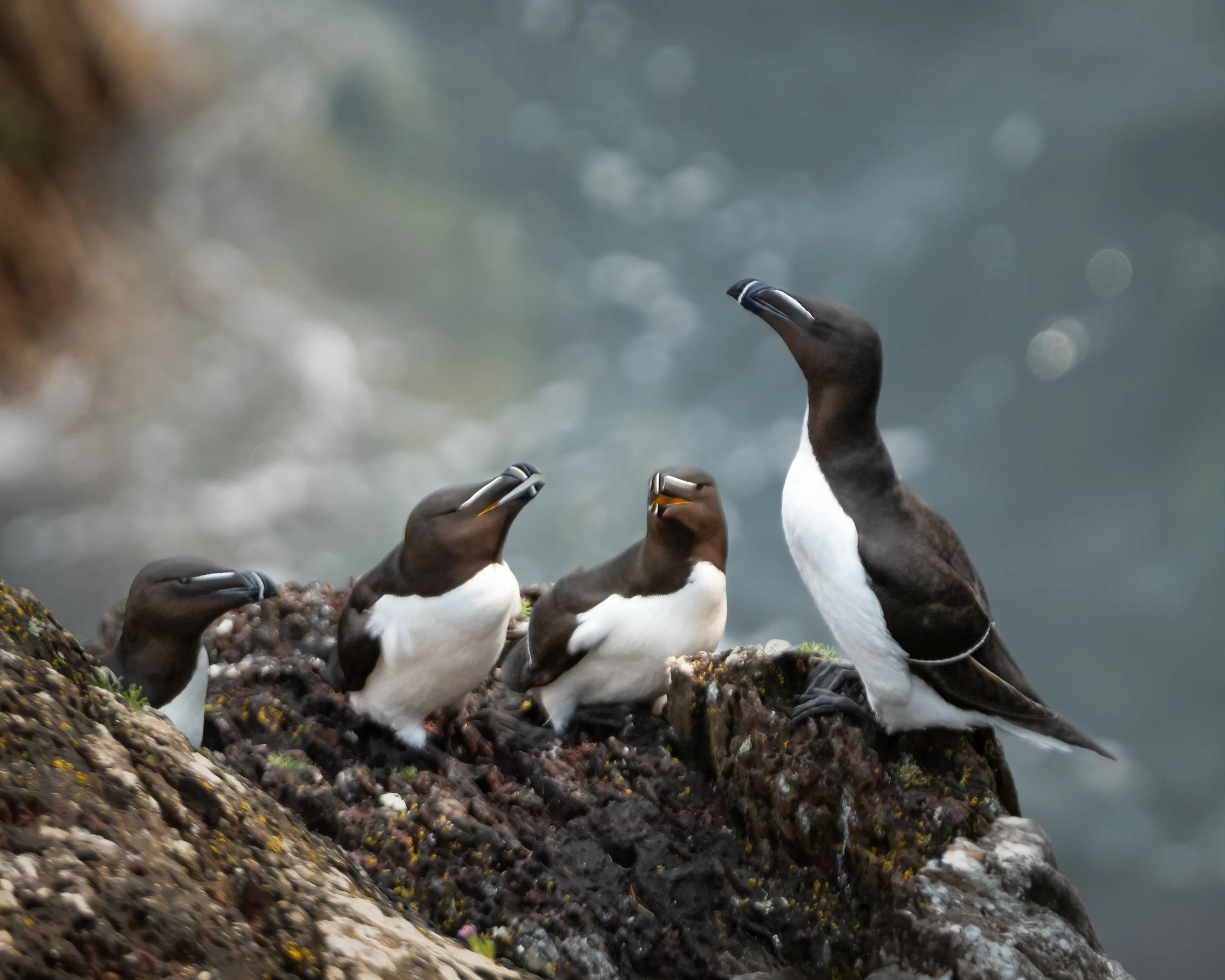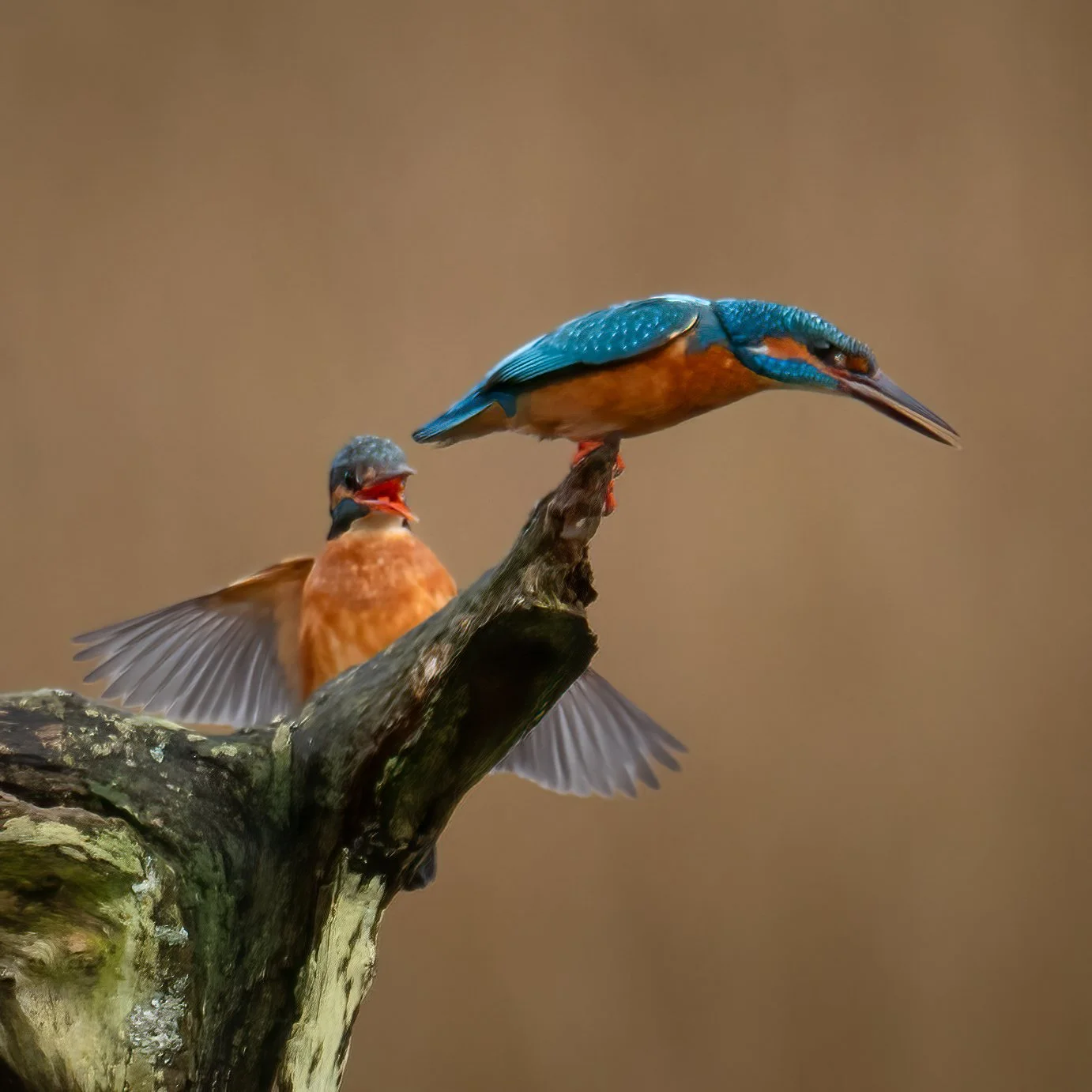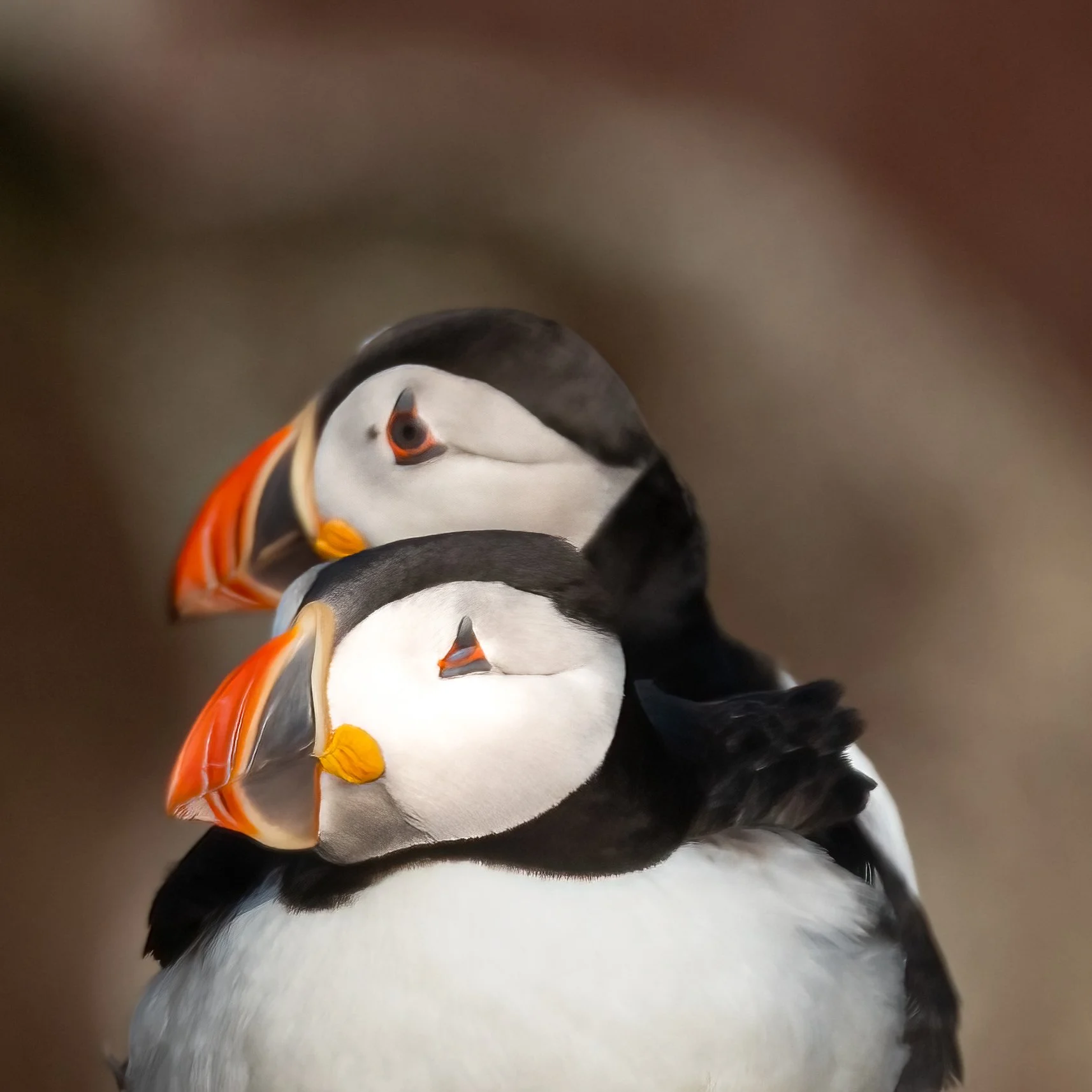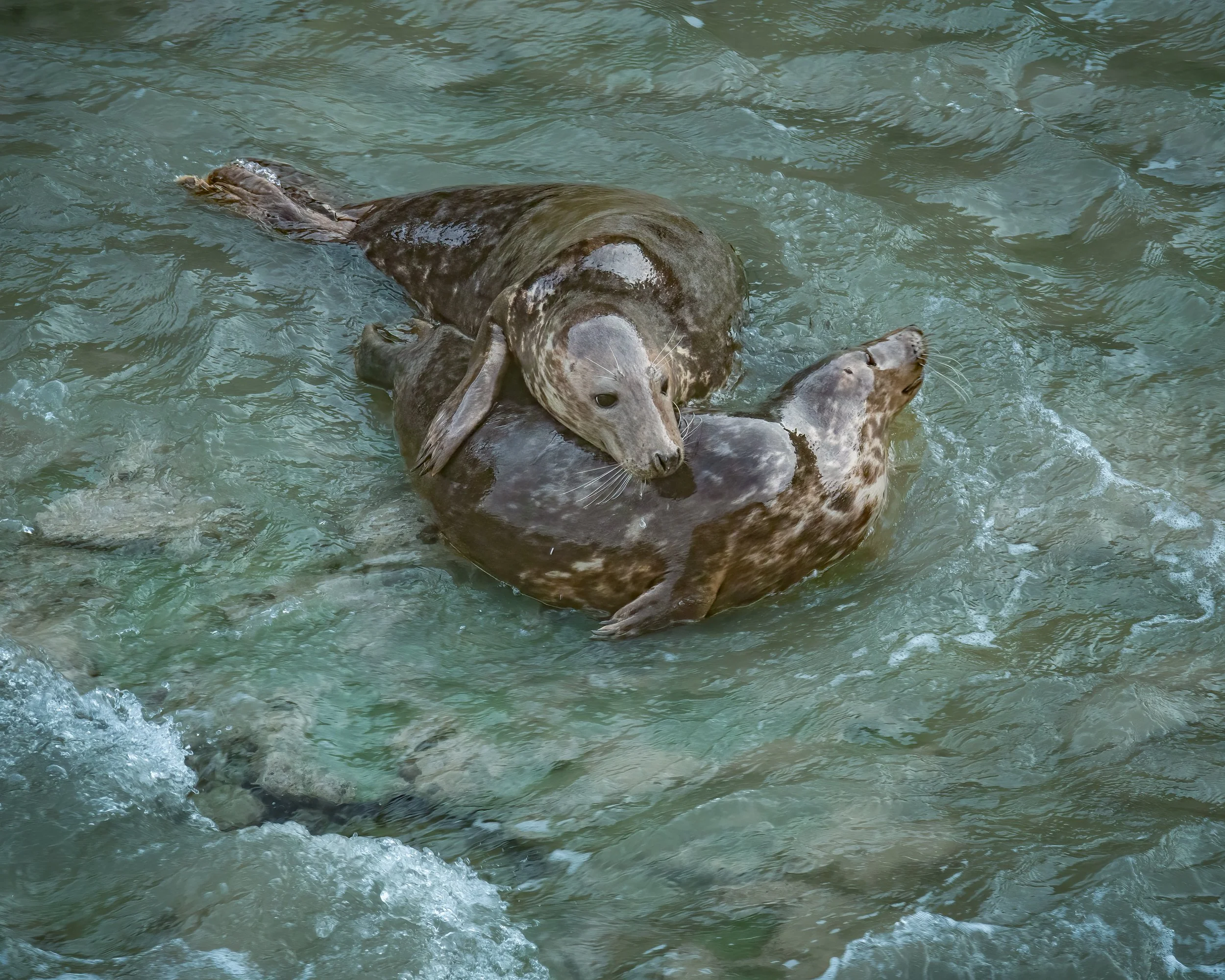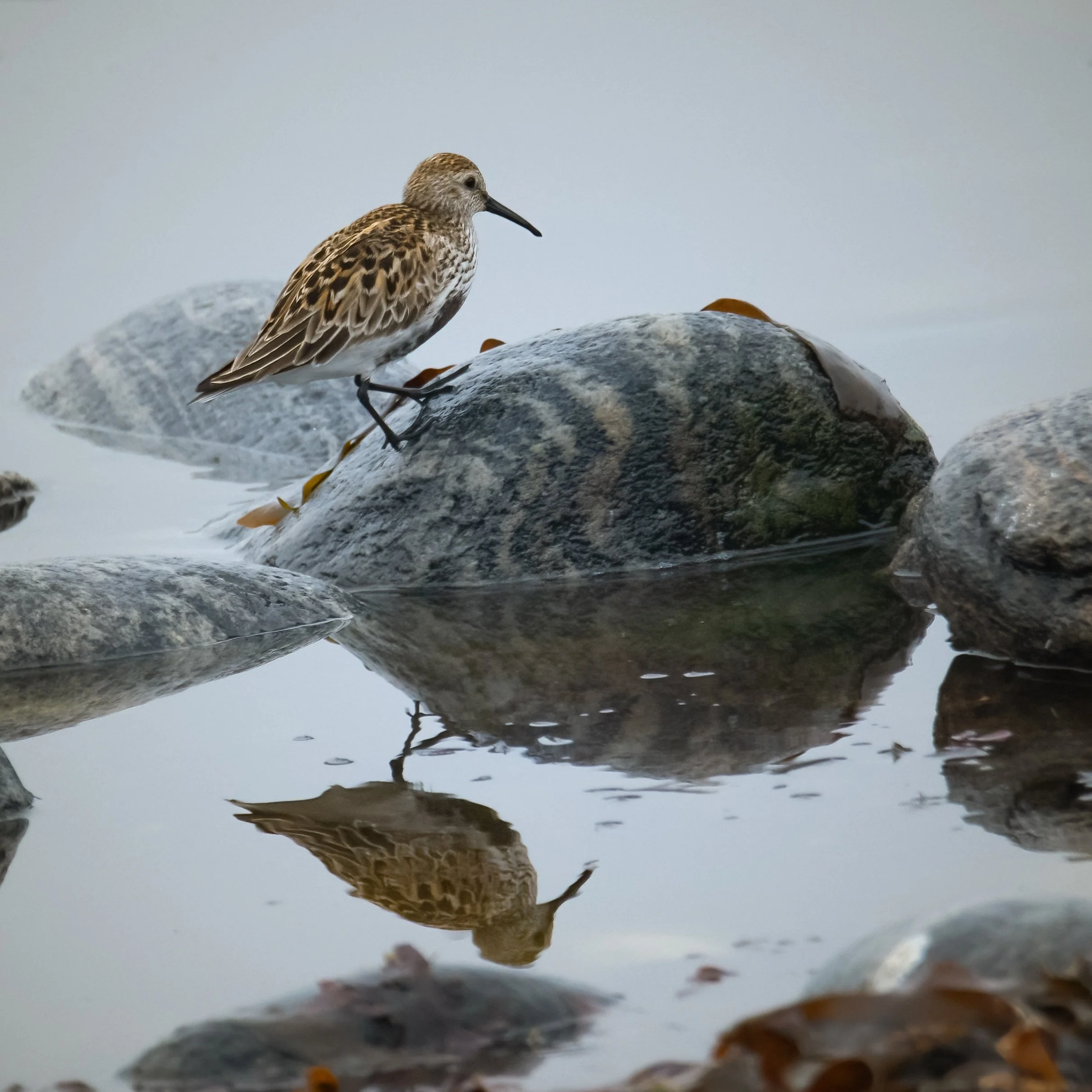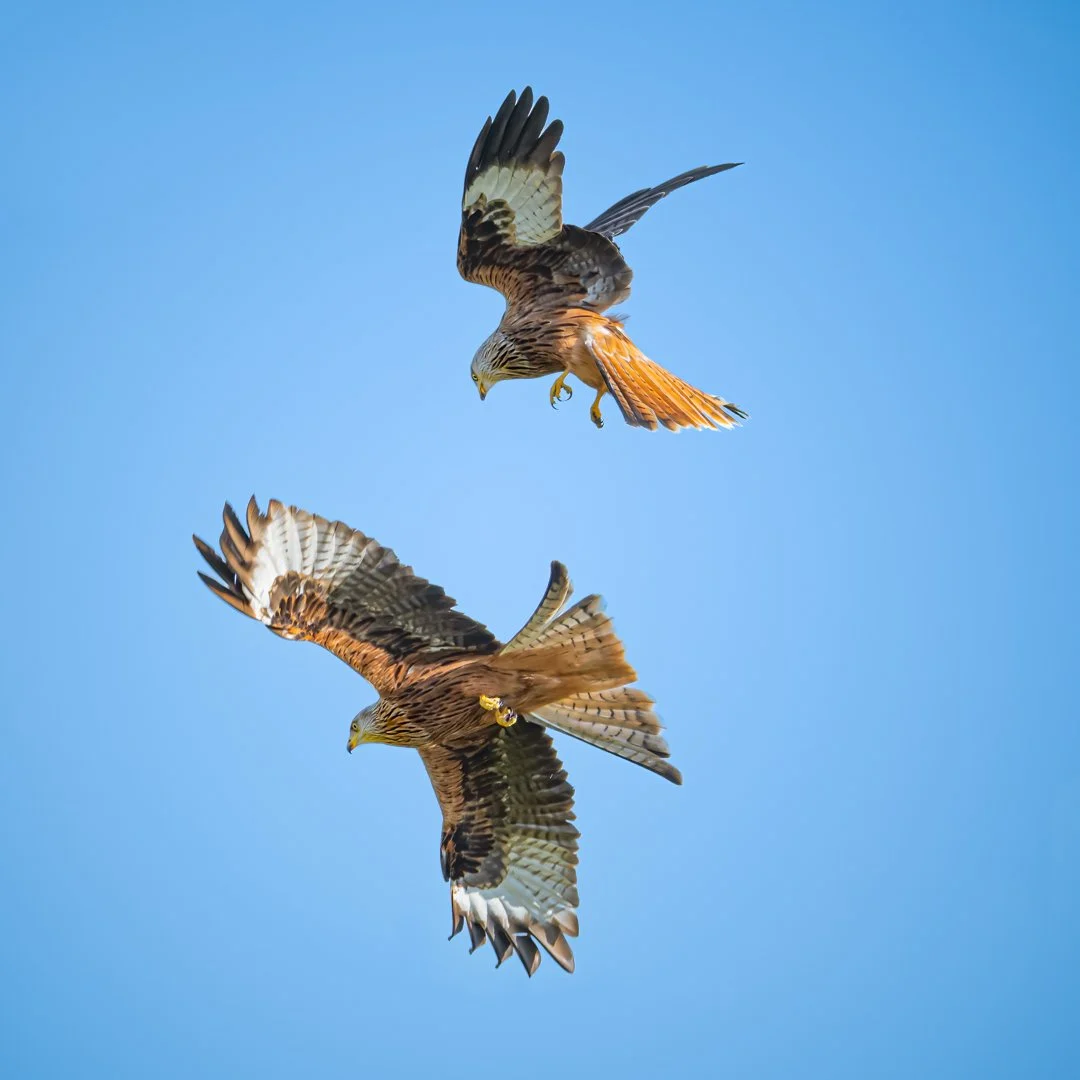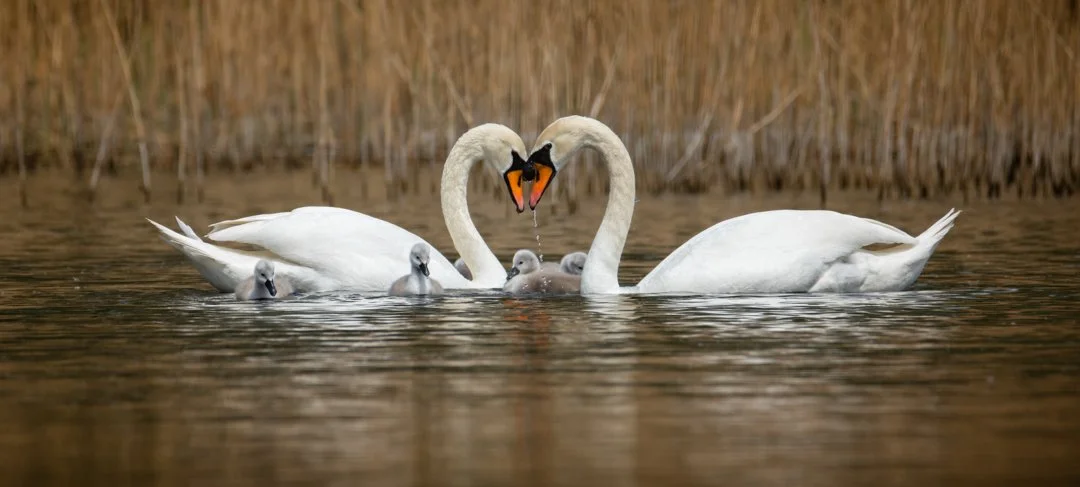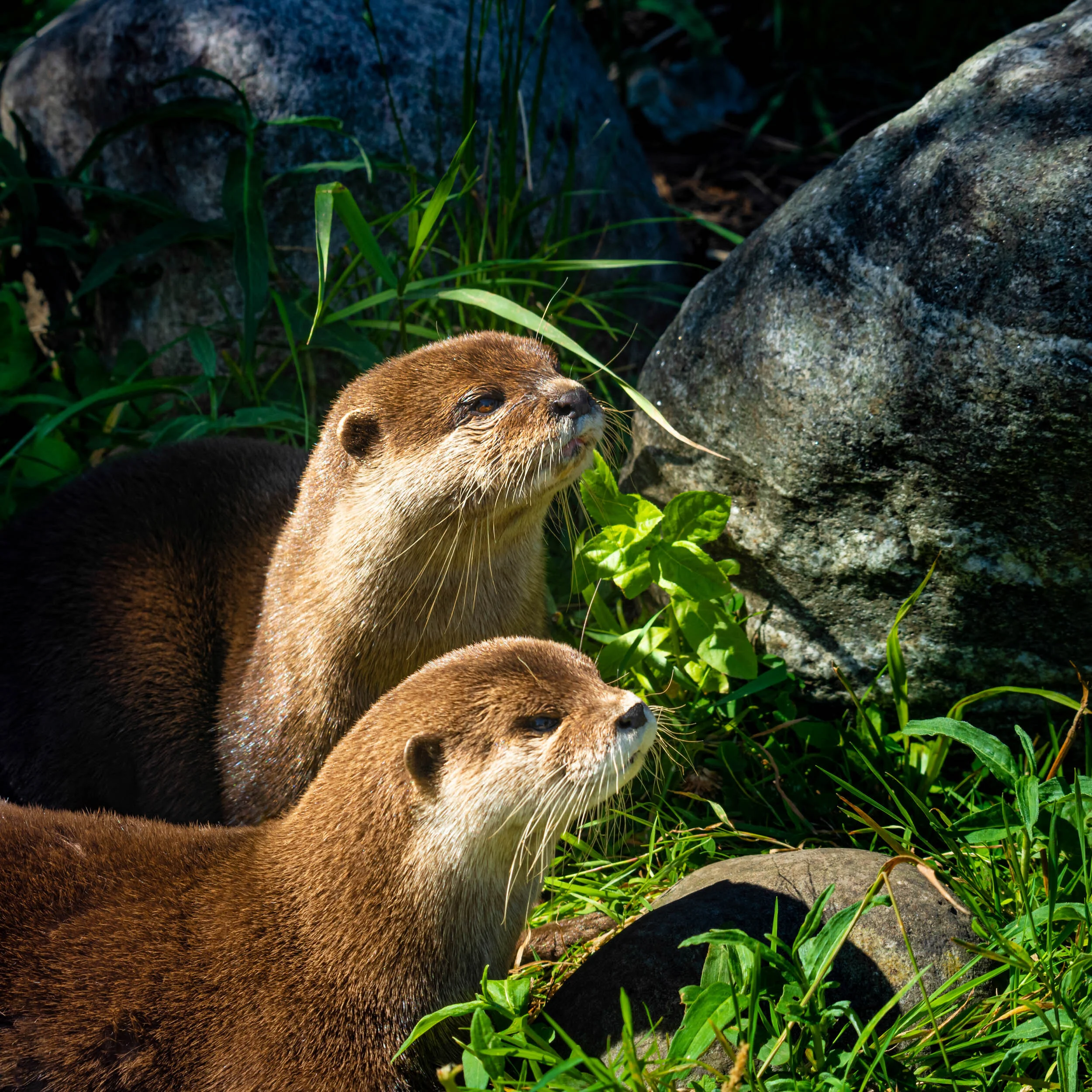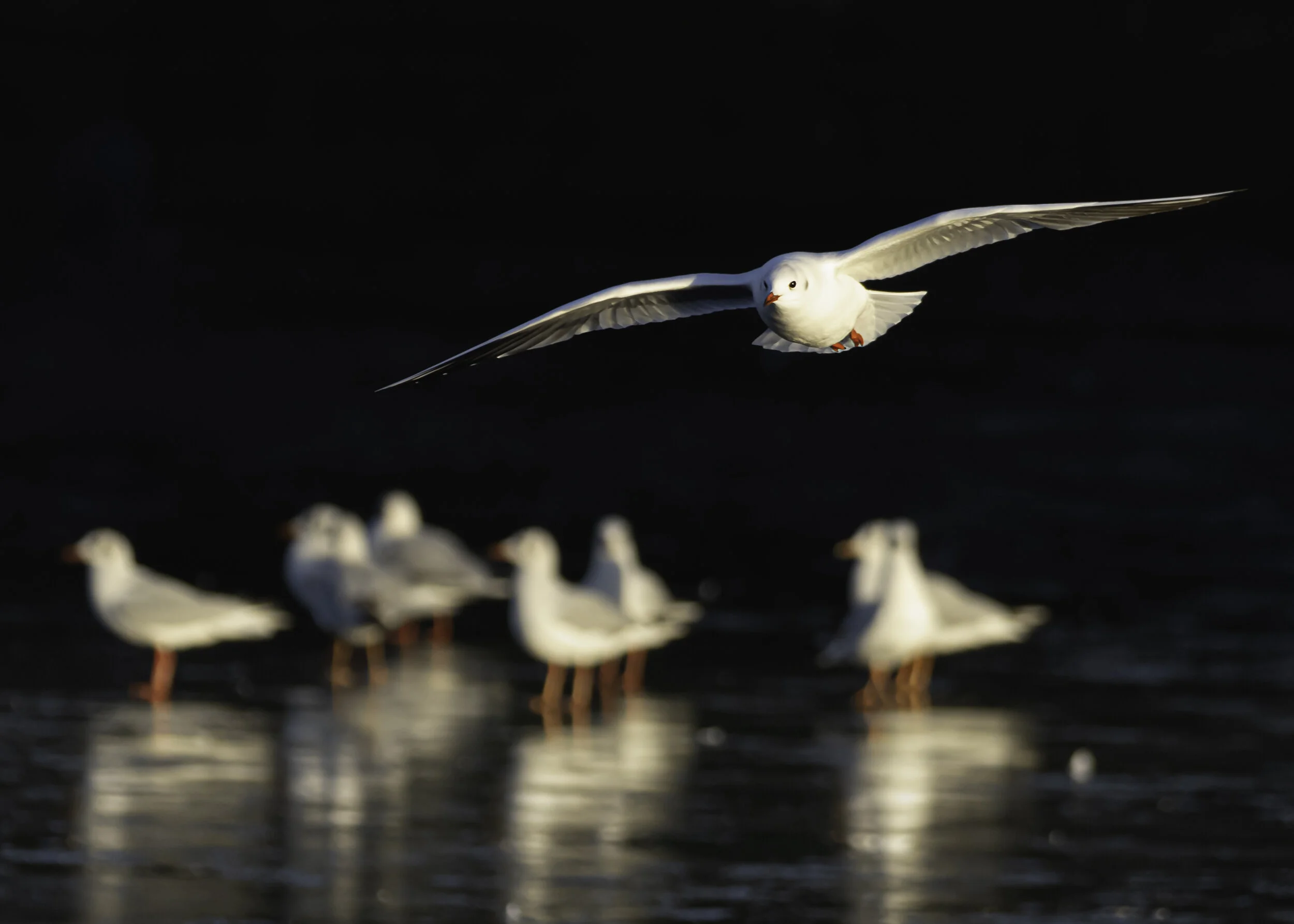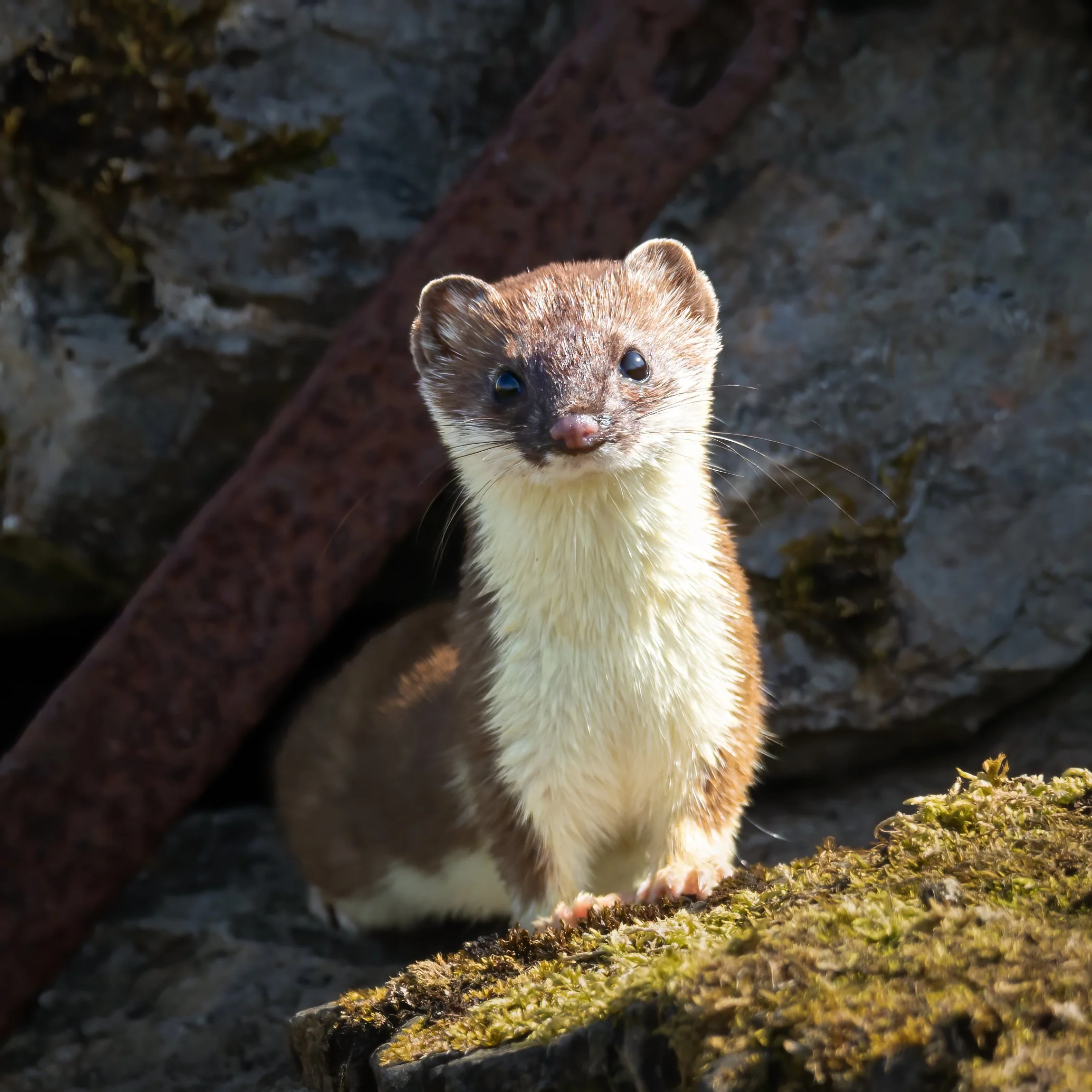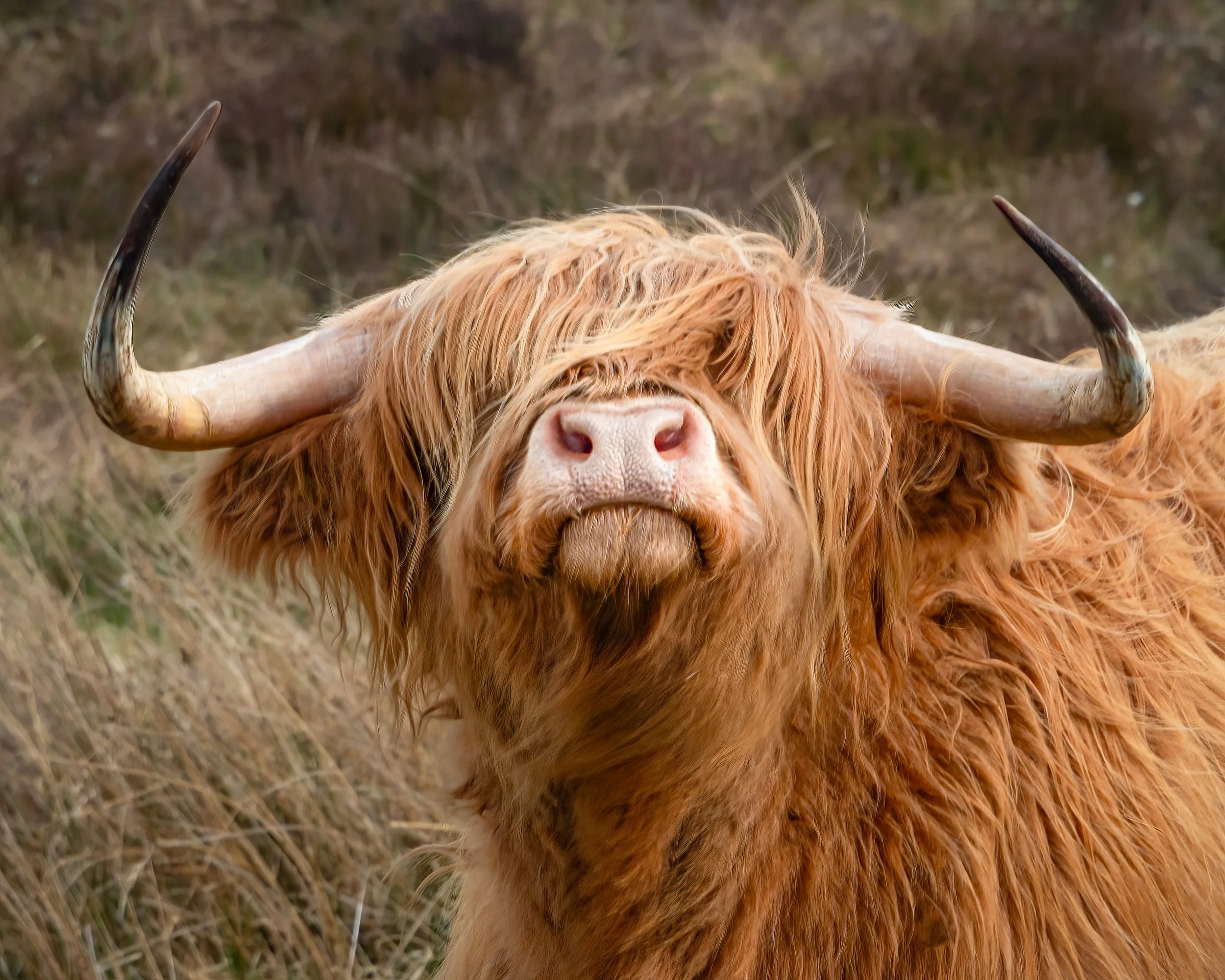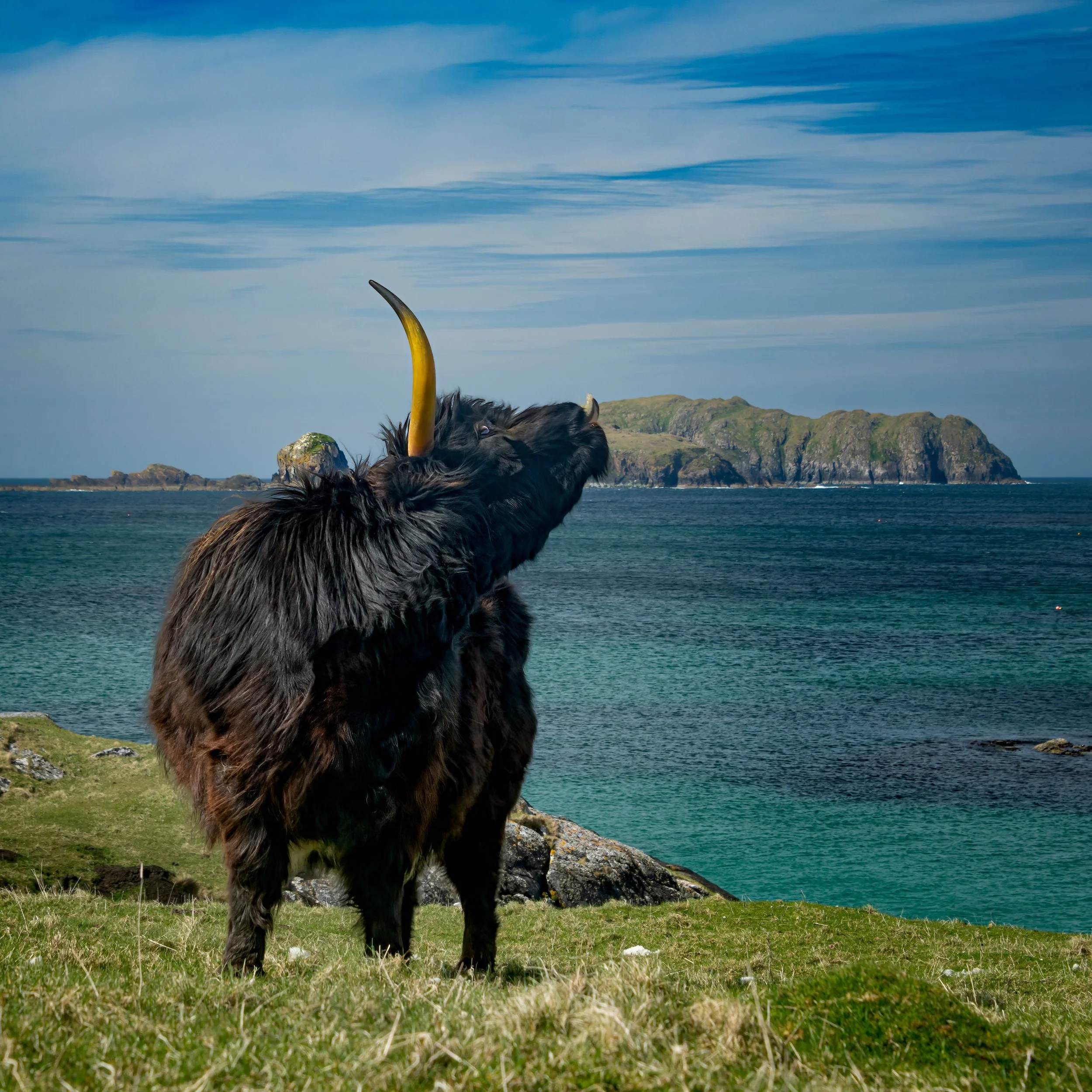WILDLIFE
“Each species is a masterpiece, assembled with extreme care and genius”
Watching gannets is hypnotic! They are actually the largest sea birds in the North Atlantic, yet true athletes of the air - when they dive for fish they reach speeds of around 100kph. I love their streamlined faces and blue eyes, and I was lucky to capture this image of a gannet cruising above the cliffs at Bempton reserve in Yorkshire. With the wings arched forward framing the face, its character of steely determination is apparent!
It was a very good mid--October day for this egret! I watched it catch at least three eels and three dragonflies in the space of about half an hour. The egret must have looked very scary to its prey, and I have tried to frame the image with that in mind. It’s always hard to photograph white birds, as it is so easy to over-expose them, but then you lose and the texture and detail of its feathers.
A curlew coming in to land at Teifi Marshes, as a cygent looks on. I liked here the contrast of slow smooth motion in one direction of the cygnet set against the faster and jerkier motion of the landing curlew, going in the opposite direction; and it almost looks as if the curlew is leapfrogging over the cygnet’s back. As the day was coming to an end and the light was low, even with a high ISO value the shutter speed was relatively low, hence the blurred wingtips: but I’m hoping that contributes positively to the sense of motion…
A puffin attempting to land on Skomer Island. It almost feels like these birds have begun to lose their ability to fly - their wings flap manically as they cruise along, and landing seems a bit hit and miss, as they sometimes topple over as they reach the ground. Fast and unpredictable in the air, they are a challenge to photograph in flight at first. A fast shutter speed is necessary, but having the wing tips slightly blurred can emphasise the sense of movement. Everyone loves to photograph these unique and iconic birds, and there are tens of thousands of them on Skomer. With no trees on Skomer to nest in, this is no problem for the puffins, as they make their nests in underground burrows.
Another puffin image, on the smaller island of Skokholm which neighbours Skomer. Puffins are often photographed with a mouth full of sand eels - during breeding season the puffins bring the eels to their nests to feed their young. Every time they arrive with their beaks full, black-backed gulls await them and try to catch them and take the eels. It’s a frantic race to disappear into the safety of their nests, though often the puffins decide not to land but to do another circuit if the odds are not looking good. Here, the puffin is appraising the situation before landing.
At Teifi marshes, on the Teifi estuary near Cilgerran, curlews are a common site. I find them an incredibly characterful bird, with their small heads, very long beaks and beady eyes. They can look wonderfully weird, as this bird does here, having a preen. Curlews are also known for their haunting cry.
On the islands of Skomer and Skokholm the razorbills are as numerous as the puffins, and although they don’t have the brightly coloured beak of the puffin, their looks are equally fascinating with the white lines going from the eye to the beak and then from top to bottom of the beak; also on the edges of their wings. Razorbills nest on the cliffs and you can frequently see them together as a pair showing affection to each other in various ways. Their flying style is similar to that of the puffin. The razorbills in this image are on Skokholm
Kingfisher rivalry at Teifi marshes. The question is: who is going to get the best perch? This is typical behaviour with juvenile kingfishers, which I believe the ones here are. These birds are very common in this part of the river, and the wildlife centre, run by the Wildlife Trust for South and West Wales, maintains a series of hides which form an ideal place from which to observe kingfishers and their behaviour.
Common frogs in my garden in Newcastle Emlyn, Wales. Photographed at night with a flash and diffuser. In order to get the focus exactly onto the subjects, I needed to have a light already shining in the direction of the frogs, as the autofocus does not work in the dark. That torchlight also helped because the frogs were attracted to this light, and would perch at the edge of the pool without moving, making it easier to get the photograph. As well as the marsh marigold leaves, amongst which the frogs would like to secrete themselves, you can see a large pile of frogspawn that the right hand frog is in amongst! The combination of the light from the torch and the diffused flash gave a pleasing overall effect.
More Skokholm puffins. Photographing pairs or groups of puffins on the ground can be as interesting as those in flight, as they demonstrate dynamic relationships which can be touching or humorous in turn. As they are fairly still on the ground a slower shutter speed can be used, but at the same time a narrower aperture needs to be set which can ensure that all the birds are in focus, even if they are at slightly different distances from the camera lens.
Grey seals at Flamborough Head, Yorkshire in mating season. At this time it’s important not to disturb the seals by getting down the cliffs to the beach where large numbers can be seen, so this photo was taken from the cliff above. These displays of affection, along with cavorting together in the waves, is very common at this time and fascinating to watch. The challenge here was to ensure that the faces were pointing as much towards the camera as possible, that their interaction demonstrated their affection, and that the wave patterns of the sea around them provided a good visual frame: a question of waiting and taking a lot of pictures, many of which could be deleted later. The shutter speed needed to be very quick here, not because of fast motion, but because of the distance of the seals from the camera.
I chose this image of a dunlin because I loved the reflections as well as the patterns on the rounded rocks; the softness in the image is also helped by the hazy conditions. This dunlin had been hopping from stone to stone for a while. Here I’ve managed to convey some sense of movement by dint of the dunlin having its legs on the sloping side of the rock, which would not have been tenable had the dunlin not been moving up to the top of the rock. This was photographed near Llanrhystud on the Ceredigion coast.
Barcud Goch is the Welsh name for the Red Kite; the reintroduction of this species three or four decades ago in Mid-Wales has been an outright success. This bird is now extremely common throughout Mid and West Wales (and increasingly further afield). Red kites can easily be identified by the shape of their tails, and they are a wonderfully attractive bird. There is a feeding station at Llandeusant, near Black Mountain in Carmarthenshire, which is a great place to photograph kites in action. A situation where the sun is quite low in the sky and the bird angles itself so that its underparts catch the light will enable the photographer to show the beautiful colours and patterns of its plumage. I was very pleased to get this image of two red kites which were both interacting and close enough to each other for them both to be in focus.
Swan family, Bedfont Lakes, near Heathrow. I lived for a while in Hounslow, and never ceased to marvel at how rich an area it was for wildlife. So many parks are nearby, as well as the Thames nearby at Osterley. One such park was Bedfont Lakes, which almost adjoins Heathrow airport, and yet was a haven for bird life on its lakes, as well as many other species in its copious woodlands. Needless to say I was a frequent visitor. The image above of a swan family has been a big favourite amongst viewers, who love the symmetry, the simplicity and the heart shape made by the swans’ necks. Shamelessly sentimental!
The WWT (Wildfowl and Wetlands Trust) are an extraordinary national resource for conservation of wetlands. One of their locations is Barnes, in the heart of West London on the river Thames. Visitors will find it hard to believe that they are in a big city - it feels as if it is in the heart of a wild rural location. As well as countless birds, it contains a rich variety of plant life, insects and, in one corner, otters. The otters are enclosed in their area, but this is sufficiently large and includes rocks, a large pond and plenty of undergrowth, so it feels like they are in the wild, but visitors get the chance to watch them in their own environment. I have included this image as an exception to my rule only to show wild animals in their natural habitat. Thereby I’m also paying tribute to the incredible work done by the WWT. Other WWT locations include Slimbridge and Llanelli. I’m pleased with this image of two otters playing together.
Osterley Park in West London is a haven for birds, amongst which are large numbers of black-headed gulls (yes, they don’t always have black heads!). I was observing the behaviour of these one winter morning, camera in hand, when I noticed some of them flying low over the water, whilst others were standing on the ice which was covering the lake. I managed to get an sharp image of a gull in flight, with the group standing on the ice as a blurred background. The reflections also looked really effective. Gull identification is very hard: plumage varies a lot depending on season, age and gender!
Stoat. Durness, on the northern coast of Scotland, is known for bird and other wildlife. I had been watching the flight and courtship of lapwings at the edge of a small lochan when all of a sudden this stoat appeared about three metres away and stopped dead in its tracks as it saw me. I thought that I should not move for a bit, so that it might get used to my presence and I could then slowly turn and photograph it; unfortunately it almost straight away ran past me and entered a reed bed at the shore of the lochan; I hadn’t managed to photograph it. Later in the day I had travelled around the lochan and seen various other species such as hooper swans and several varieties of duck, then, before leaving in the late afternoon, I thought I would briefly return to my original spot, on the offchance that the stoat would return from the reed bank. I couldn’t have been more surprised when this is what actually happened. This time I managed to observe the stoat for several minutes. I’m really pleased with the close-up images I got, although I would prefer not to have had to include the bit of scrap metal which the stoat was standing in front of.
Highland Cattle demand to be photographed. I’ve got two images here. This one, taken near Garve in the Scottish highlands, is a close-up, with a hint of one eye visible and its head raised as if saying “yes, and what do you want?”. The horns and shaggy hair make its look irresistible. A photo like this has to be very sharp, especially the mouth and nose area in the centre, but above all expressive.
A very different Highland Cattle image. This one shows the whole animal, dynamic, throwing its head back, revealing its eye, and showing attitude It’s also there in the beautiful context of Bostadh, part of Great Bernera on the Isle of Lewis, with the isle of Flodaigh over the water. So much of the essence of the Scottish Islands!
Wild goats in Glen Strathfarrar. I loved these creatures which seemed to have so much character: their eyes had a commanding stare, and their long hair,, especially the dark hair on their faces, gave them an aura of wisdom, and their horns strength and authority. Of course, that is all anthropomorphism, but I still found them to be fascinating creatures. I managed to get this pair exactly as I wanted, one goat with its face to the camera and the other in profile; and one standing and one sitting with each looking in a different direction on different levels.
